I Build Ghost Bikes. Here’s What It’s Taught Me About Who Dies on a Bike.
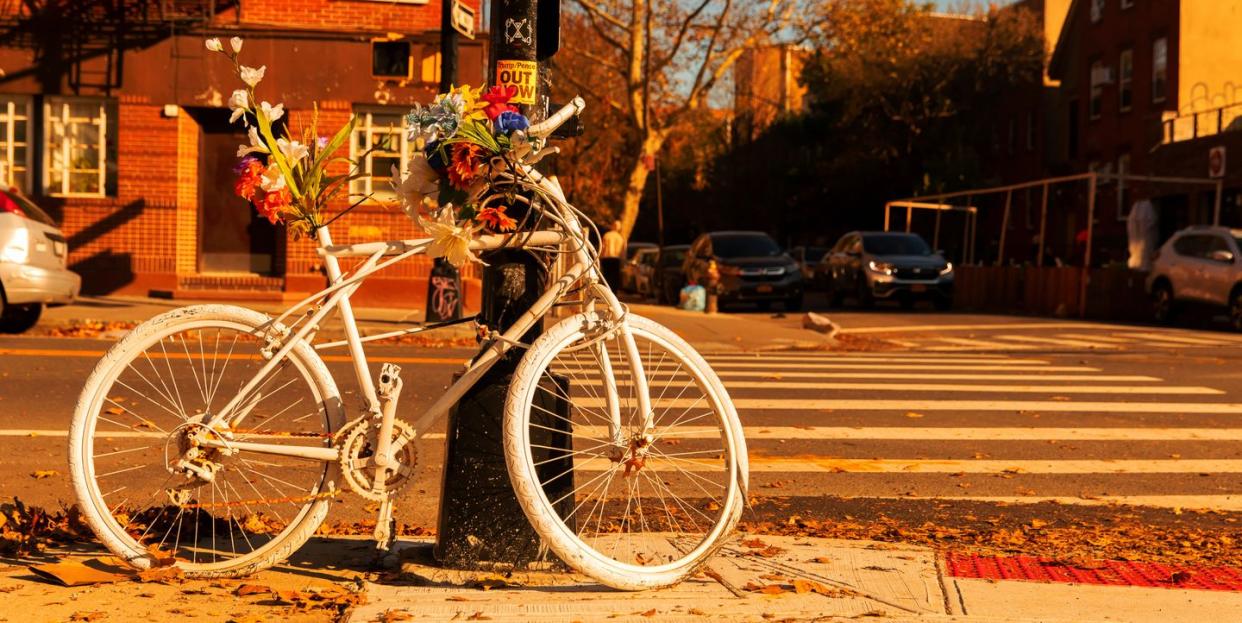
The first time I ever made a ghost bike, I said I hoped I would never do it again. My friends and I were not trying to start a movement. Rather, it was personal. We built New York City’s first ghost bike because we were people who rode bikes, and one of us had just seen a dead body.
In the early aughts, I was part of a small street art collective called Visual Resistance. On a summer day in 2005, at a regularly scheduled meeting, one of our ranks, Kevin Caplicki, told a story about an event that had been haunting him. A woman named Liz Padilla had been struck and killed on her bike by a truck driver. Kevin had ridden by on his bike right after it happened. That is how it started.
At our meeting, someone mentioned an art installation in Pittsburgh—a white bike locked at the site of a crash. Then someone else said there was a busted old bike in the backyard. We had spray paint, of course.
Today, ghost bikes can be found in at least 220 cities around the world on five continents. In the 15-odd years since that summer day, I’ve helped build and install many of New York City’s 250-plus ghost bikes. The project has changed hands a few times but I never stopped, and now I make ghost bikes with a small group of volunteers for the New York City Ghost Bike Project.
Right now, I am helping to plan a workday. We have 14 ghost bikes to build for some of the 22 people killed on bikes in New York so far in 2020, more than we can finish in a single day, especially with social distancing. The list has been growing since the city shut down and more people began riding bikes out of contagion safety and economic necessity. The shutdown meant fewer cars were on the road, but there was also more space to drive recklessly.
Of course, like the breadth of reasons that more people began to be killed on their bikes as the city shut down, there is so much about vulnerability to premature death that a simple white bike cannot explain. These are the steps we take to make a ghost bike—and what the act of making one can tell you about what it means to ride a bike.

Step One: Wait for Someone to Die
In most U.S. cities, you do not have to wait long for someone to die. In New York City, the dead arrive once or twice a month, year after year. The year we built the first ghost bike, 24 people were killed on their bikes. In our best year, in 2018, only 10 were killed. Last year, our worst, we lost 29.
To find the dead, search newspapers and set alerts to ping you when “bike accident” or “cyclist killed” appears. You will find that the dead will come named and unnamed, but regardless, their deaths will be blamed on them.
The cyclist fell under the wheels of the truck. The cyclist rode into the car door. The cyclist came out of nowhere.
This was true of the three people most recently added to our build list: Salvador Chairez-Rodriguez, a food delivery worker killed when, according to officials, he “blew through a red light and crashed into the side of southbound Q18 bus”; an unnamed 34-year-old who police claimed “collided into the rear” of a truck; and Juan Tiu-Caxaj, a food delivery worker killed in November when, according to police, he “failed to stop at a stop sign, colliding with a 2020 Honda CRV.” And it was true of the first person we ever built a ghost bike for: Liz Padilla, a legal aid lawyer on her way to work who, according to the newspaper, “hit the side of the moving ice cream truck, causing her to topple under the vehicle’s large rear wheels.”
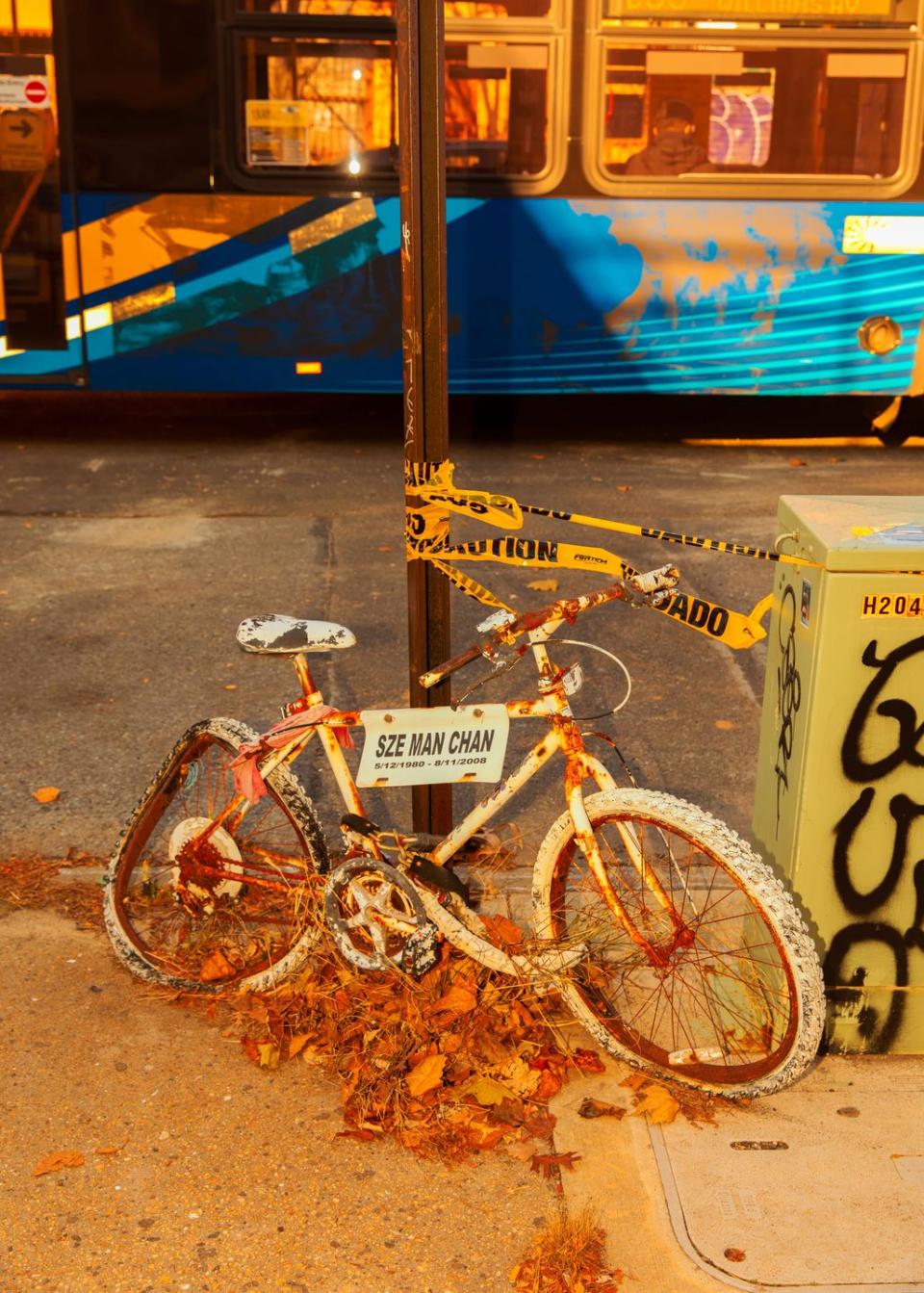
Step Two: Find a Bike
When we build ghost bikes, we use bikes that no longer function, their frames cracked and seat posts seized. Because we know that the more numbers of people who ride bikes, the safer we all are, we never want to take a working bike off the street. For years, these came to us in donations and street finds. Today, a local bike recycler collects for us the bikes it cannot salvage.
But the first ghost bike was one of our own. After our meeting, we retreated to an asphalt Brooklyn backyard and dug the old bike out from under ivy. We learned as we painted: Watch for drips. Spokes are easiest to coat in short bursts at close range. Gloss spray paint is too shiny for a ghost.
From a manila folder, someone cut a stencil, and on a piece of scrap wood painted white and drilled to fit a street sign, we spray-painted the inscription:
Liz Padilla
28 Years Old
Killed by Truck
June 9, 2005
Rest in Peace
What I remember most was the sadness that wafted in with the white cloud of paint. Painting that first bike, I thought of a woman I knew nothing about except that, like me, she rode a bike. I imagined her life and horrible death. I pictured the people she left behind. In the act of making, I felt mournful about something that before, I might never have known.
We carried the bike to the site of the crash, locked it to a street sign, and bolted the wooden plaque above it. Never again, we said to one another, wholly somber; I hope we never have to do that again.
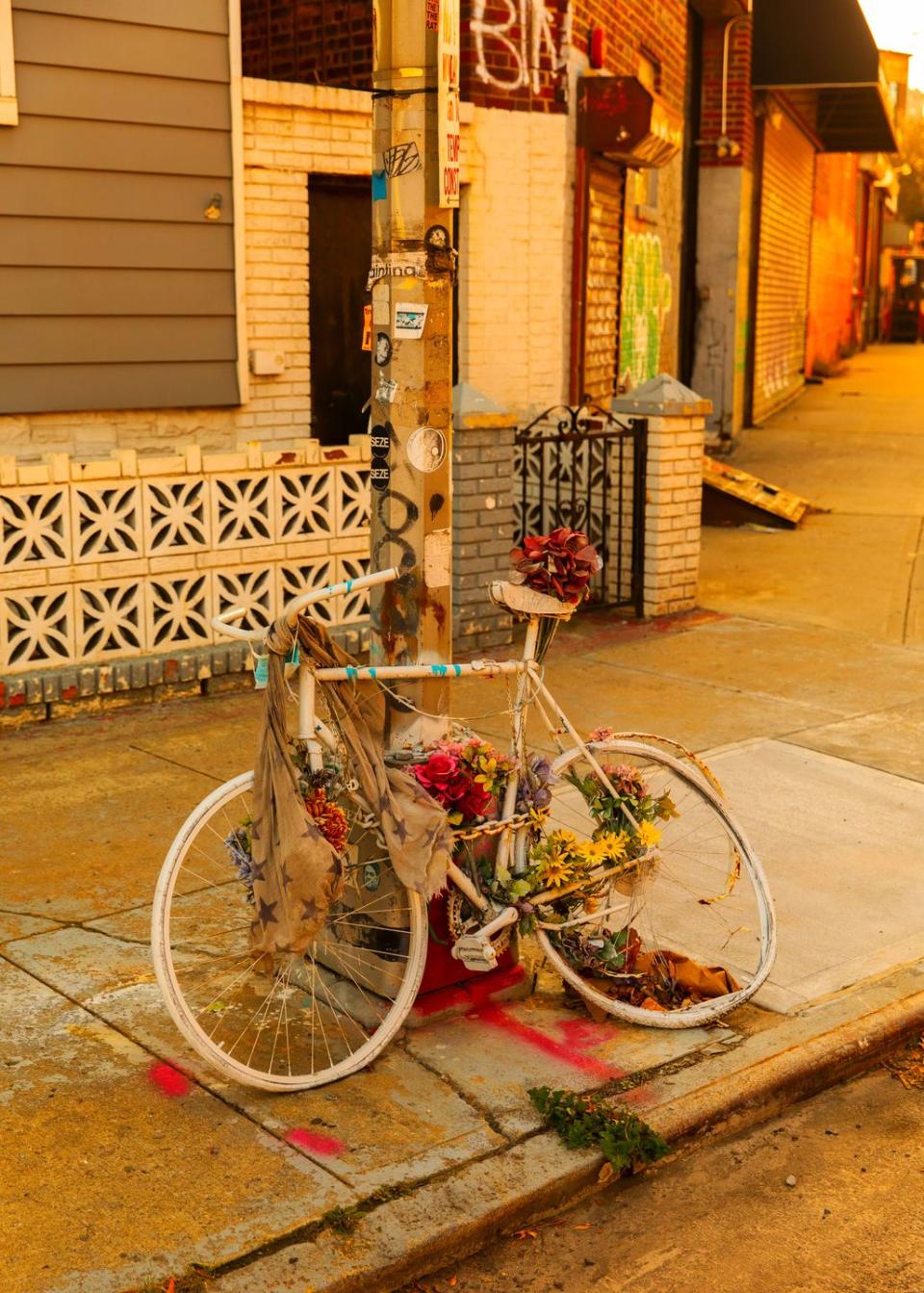

Step Three: Strip It Down and Paint It White
Not long after, a friend of a friend got in touch about the ghost bike we had built. Could we do it again, they asked, for a woman they knew? Brandie Bailey was 21 when she was killed on her bike on Houston Street and Avenue A. It happened a month before Liz Padilla’s death. How could we say no? We built a ghost bike and installed it at the spot where she died.
Brandie Bailey
21 Years Old
Killed by Truck
May 8, 2005
Rest in Peace
Afterward, we said to one another, never again; I hope we never have to do that again.
But a week later, another call came. Andrew Morgan, age 25, was killed on his bike on Houston and Elizabeth Street. We built a ghost bike and installed it at the spot where he died.
Andrew Ross Morgan
25 Years Old
Killed by Truck
June 22, 2005
Rest in Peace
That year, we built 13 ghost bikes. As we built, we learned how to make a ghost bike that lasts: Clear the bike down to its barest bones. It must look like a bike but not be rideable like a bike. Remove most anything that moves to reduce friction on the paint and to reduce the hope of thieves. Strip off the brake calipers and levers. Pull off the shifters and the chain. Get rid of pie plates, reflectors, bells, and whistles. Sand off any rust and decals. Rip the seat cushions down to the bare plastic or metal frame. Next, lay down a coat of white primer, then two cans’ worth of matte white spray paint.
By the end of that first year, we had a method. Once I started, I felt I could never stop. Part of the reason was the families.
Step Four: Try to Find the Family
Today we put some effort into finding the families of the dead. We scan news stories for names and message strangers on Facebook. This is important, because not everyone wants a ghost bike. For some people, a ghost bike is a sacrilege. For others, often when a child is killed, a ghost bike at the site means a ghost bike outside their front door. So we try our best to ask. If we cannot find the family, we put up a ghost bike anyway. Sometimes that means we end up taking a ghost bike back down by request.
But most of the time, when a family finds us it is to say thank you, because one thing a ghost bike can do is cleanse a place of a horrible death. For the families, ghost bikes often become a location to mourn, changing a crime scene into more of a memorial. In this way a ghost bike serves two purposes. It is for the family but, as it stands in public space, a ghost bike is also for the collective memory.
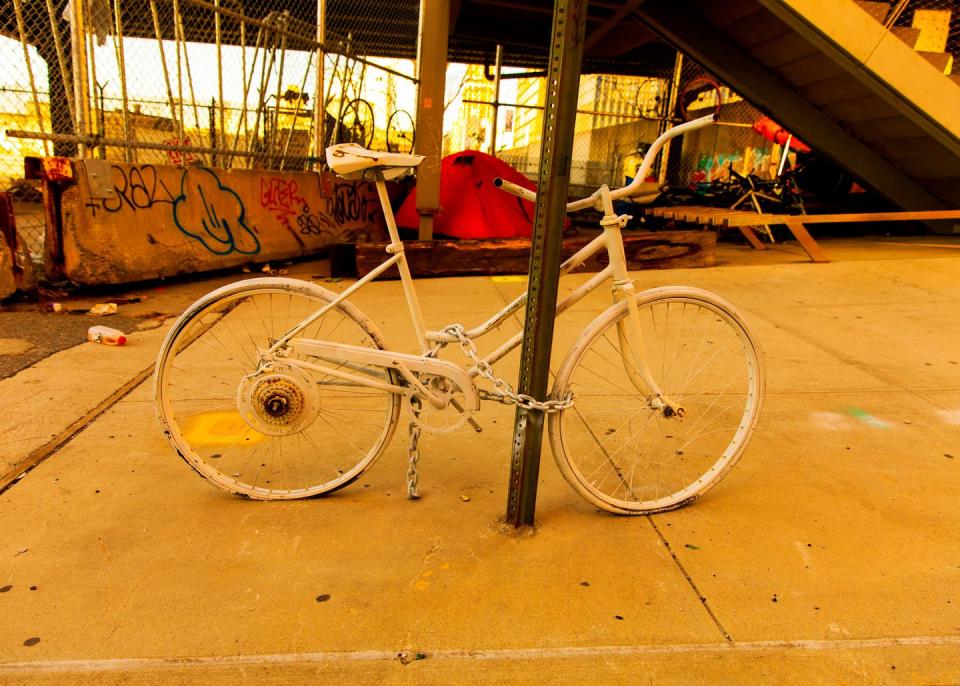
Step Five: Lock It in Place
When you put a ghost bike on the street, keep it there with six feet of chain and a heavy lock, both painted white. (At least in New York City, locking anything to a street sign is legally murky. People who are especially vulnerable to police violence should proceed with caution.) Be careful to not block a curb cut. If someone was killed outside a business, go inside and say hello before you lock the ghost bike outside. Some business owners will say no, no, no, not here. And others will say they saw the crash, are glad for the memorial, and will care for it.
When you are done, you will have made a mark on public space. In this way, a ghost bike links the death of a person with the place where they were killed, and in this link, there is something to learn.
Consider the two ghost bikes we built in close succession, for Andrew Morgan and Brandie Bailey—two people killed on bikes, on the same street, less than a half mile and only 45 days apart. With two ghost bikes installed on the street, it became clear that this specific place was a problem. Would anyone have seen the connection had we not marked those deaths where they happened? (As if to underline the point, a few weeks after Morgan’s ghost bike was installed, a cab driver would jump the curb and run it over, along with the street sign it was attached to. A local bartender held onto the remnants until we could come to unbend the handlebar, straighten the seat post, and find another street sign to lock the memorial in place.)

The more ghost bikes I built, the more I found even broader lessons. Across boroughs, for example, ghost bikes were needed at intersections and on streets without bike lanes, because those places were where most were killed. In this way, the ghost bikes mapped what needed to be done: Fix a street. Build a bike lane. Protect an intersection. Each death was a lesson, and by marking the dead, the lessons appeared stark.
But there were other patterns too, ones that a ghost bike offered nothing for. These emerged only after years of building ghost bikes, as I met the families of the dead. The people we built ghost bikes for were disproportionately Black, Latino, and Asian. Often they were immigrants; often they were killed on the job, or riding to and from work in the dim of late night and early morning.
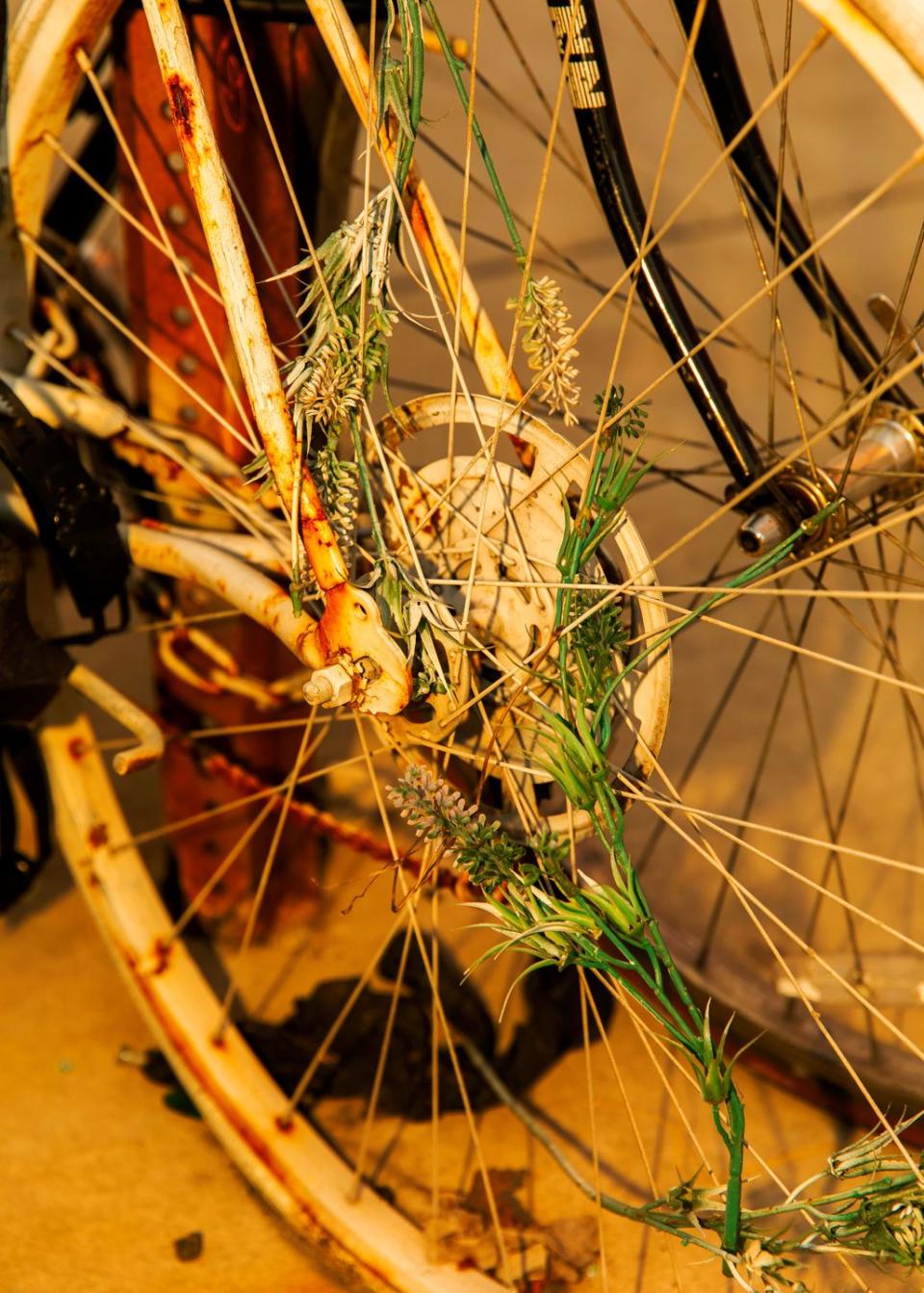
This is where the utility of a ghost bike runs out. A ghost bike may clear a place of violence to make space for mourning, and a ghost bike may mark danger in a place that cries out for infrastructure, but it cannot explain who is killed on their bike and why. And the truth is that some people who are killed on their bikes die because they have no other choice but to ride one.
In New York and across the United States, transportation access is a racial and economic barrier. Today more than a million unemployed people have stopped looking for work because family or transportation issues make returning to work impossible. While other markers of the economy have improved, this number has not. With public transit budgets being cut nationwide, and even the cheapest used car costing a few thousand dollars, the simplest and most affordable transportation option is a bike. For people who ride bikes because they have no other choice, a bike can bring transportation freedom, access to a paycheck, and also vulnerability to premature death.
What is the difference between a ghost bike for a person who chooses to ride a bike and a ghost bike for a person who must ride a bike? Nothing. And that is where the ghost bike falls short.
It is the invisible difference between opting into one vulnerability, choosing to be a lonely cyclist in a world of cars, and being a person for whom vulnerabilities—poverty, overpolicing, and still that same risk of riding—are neither exclusive nor a choice. The first vulnerability, the chosen one, is the stuff of infrastructure. It can be fixed with a bike lane. For the latter cyclist, a bike lane is a bandage over a giant stack of vulnerabilities to premature death. All people on bikes may be most vulnerable in intersections, but some people on bikes are more vulnerable everywhere, and in intersections, doubly so. A ghost bike cannot tell you any of that.
Jessie Singer is senior editor at Transportation Alternatives and is currently writing a book titled There Are No Accidents for Simon & Schuster due out next year. She is still building ghost bikes.
You Might Also Like

